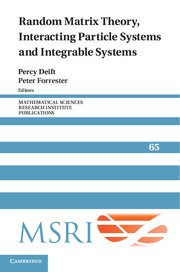Book contents
- Frontmatter
- Contents
- Preface
- Universality conjecture for all Airy, sine and Bessel kernels in the complex plane
- On a relationship between high rank cases and rank one cases of Hermitian random matrix models with external
- Riemann–Hilbert approach to the six-vertex model
- CLT for spectra of submatrices of Wigner random matrices, II: Stochastic evolution
- Critical asymptotic behavior for the Korteweg–de Vries equation and in random matrix theory
- On the asymptotics of a Toeplitz determinant with singularities
- Asymptotic analysis of the two-matrix model with a quartic potential
- Conservation laws of random matrix theory
- Asymptotics of spacing distributions 50 years later
- Applications of random matrix theory for sensor array imaging with measurement noise
- Convolution symmetries of integrable hierarchies, matrix models and τ-functions
- Universality limits via “old style” analysis
- Fluctuations and large deviations of some perturbed random matrices
- Three lectures on free probability
- Whittaker functions and relatedstochastic processes
- How long does it take to compute the eigenvalues of a random symmetric matrix?
- Exact solutions of the Kardar–Parisi–Zhang equation and weak universality for directed random polymers
- Replica analysis of the one-dimensional KPZ equation
- Asymptotic expansions for β matrix models and their applications to the universality conjecture
- KPZ scaling theory and the semidiscrete directed polymer model
- Experimental Realization Of Tracy–Widom Distributions And Beyond: Kpz Interfaces In Turbulent Liquid Crystal
- Random matrices: the four-moment theorem for Wigner ensembles
Applications of random matrix theory for sensor array imaging with measurement noise
Published online by Cambridge University Press: 29 May 2025
- Frontmatter
- Contents
- Preface
- Universality conjecture for all Airy, sine and Bessel kernels in the complex plane
- On a relationship between high rank cases and rank one cases of Hermitian random matrix models with external
- Riemann–Hilbert approach to the six-vertex model
- CLT for spectra of submatrices of Wigner random matrices, II: Stochastic evolution
- Critical asymptotic behavior for the Korteweg–de Vries equation and in random matrix theory
- On the asymptotics of a Toeplitz determinant with singularities
- Asymptotic analysis of the two-matrix model with a quartic potential
- Conservation laws of random matrix theory
- Asymptotics of spacing distributions 50 years later
- Applications of random matrix theory for sensor array imaging with measurement noise
- Convolution symmetries of integrable hierarchies, matrix models and τ-functions
- Universality limits via “old style” analysis
- Fluctuations and large deviations of some perturbed random matrices
- Three lectures on free probability
- Whittaker functions and relatedstochastic processes
- How long does it take to compute the eigenvalues of a random symmetric matrix?
- Exact solutions of the Kardar–Parisi–Zhang equation and weak universality for directed random polymers
- Replica analysis of the one-dimensional KPZ equation
- Asymptotic expansions for β matrix models and their applications to the universality conjecture
- KPZ scaling theory and the semidiscrete directed polymer model
- Experimental Realization Of Tracy–Widom Distributions And Beyond: Kpz Interfaces In Turbulent Liquid Crystal
- Random matrices: the four-moment theorem for Wigner ensembles
Summary
The imaging of a small target embedded in a medium is a central problem in sensor array imaging. The goal is to find a target embedded in a medium. The medium is probed by an array of sources, and the signals backscattered by the target are recorded by an array of receivers. The responses between all pairs of source and receiver are collected so that the available information takes the form of a response matrix. When the data are corrupted by additive measurement noise we show how tools of random matrix theory can help to detect, localize, and characterize the target.
1. Introduction
The imaging of a small target embedded in a medium is a central problem in wave sensor imaging [Angelsen 2000; Stergiopoulos 2001]. Sensor array imaging involves two steps. The first step is experimental, it consists in emitting waves from an array of sources and recording the backscattered signals by an array of receivers. The data set then consists of a matrix of recorded signals whose indices are the index of the source and the index of the receiver. The second step is numerical, it consists in processing the recorded data in order to estimate the quantities of interest in the medium, such as reflector locations. The main applications of sensor array imaging are medical imaging, geophysical exploration, and nondestructive testing.
Recently it has been shown that random matrix theory could be used in order to build a detection test based on the statistical properties of the singular values of the response matrix [Aubry and Derode 2009a; 2009b; 2010; Ammari et al. 2011; 2012]. This paper summarizes the results contained in [Ammari et al. 2011; 2012] and extends them into several important directions. First we address in this paper the case in which the source array and the receiver array are not coincident, and more generally the case in which the number of sources is different from the number of receivers. As a result the noise singular value distribution has the form of a deformed quarter circle and the statistics of the singular value associated to the target is also affected. Second we study carefully the estimation of the noise variance of the response matrix. Different estimators are studied and an estimator that achieves an efficient trade-off between bias and variance is proposed.
Information
- Type
- Chapter
- Information
- Publisher: Cambridge University PressPrint publication year: 2014
Accessibility standard: Unknown
Why this information is here
This section outlines the accessibility features of this content - including support for screen readers, full keyboard navigation and high-contrast display options. This may not be relevant for you.Accessibility Information
- 1
- Cited by
